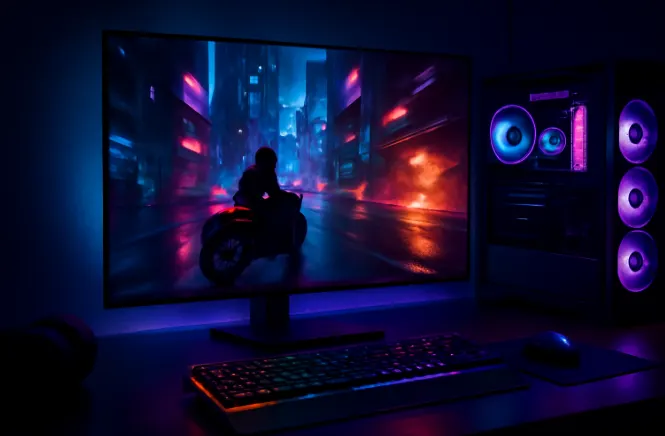The fear of screen burn-in, especially for desktop work, was the loudest warning. Close behind were complaints about how OLED panels handled text compared to standard LCDs.
Despite the uncertainty, I took the plunge and bought the LG 34GS95QE. And despite a few quirks, I loved it enough to grab a second OLED display—the SAMSUNG 27-inch Odyssey—in 2024 to use in my competitive gaming setup. After three solid years of daily use, here’s what I’ve learned—the myths, the realities, and what actually matters.
MYTH #1: OLED Burn-In Shows Up Quickly
🔥 Truth: It’s Uncommon and Often Temporary
Like many others, I was genuinely concerned about permanent burn-in. Static UI elements like taskbars, browser windows, and game HUDs seemed like prime culprits.
I’d read plenty of posts online suggesting burn-in appeared within just a few months. But even after three years of heavy daily use, my LG 34GS95QE has never shown permanent burn-in. I’ve seen brief image retention a few times, but it always went away after running the monitor’s built-in Pixel Refresh or Panel Refresh tools.
Most modern OLEDs include smart features like pixel shifting and have built-in safeguards against static image damage. On top of that, many manufacturers now offer 2–3 year burn-in warranties, which adds a layer of confidence.
MYTH #2: Pixel Refresh Will Ruin Your Workflow
🕒 Truth: It’s Manageable and Non-Intrusive
Another common complaint is that OLED monitors frequently interrupt you with pixel refresh prompts. I was worried it might kick in during work sessions or even mid-game.
In reality? Not a problem at all.
With the LG 34GS95QE, I can disable the auto-prompt entirely. Even on models where you can’t, like my SAMSUNG 27-inch Odyssey, the refresh only triggers during standby and never interrupts what I’m doing. The most I’ve had to do is tap the power button when returning to my desk.
Honestly, it serves as a gentle nudge to step away from the screen—something we could all use more often, especially when the display costs over a thousand dollars.
MYTH #3: OLED Has Terrible Text Clarity
🧠 Truth: You’ll Adjust Quickly—and It’s Getting Better
This was nearly a dealbreaker for me. I spend hours each day writing and editing, so text clarity is critical. OLED displays use a different subpixel arrangement compared to IPS monitors, which can cause slight blurring or color fringing—especially noticeable at 1440p resolution.
When I first hooked up the LG 34GS95QE, I saw the issue immediately. But after tweaking ClearType settings and display scaling in Windows, it became a non-issue. Within a couple of weeks, it stopped bothering me altogether.
Plus, newer OLED generations—especially those with 4K resolution—handle text far better, minimizing or eliminating this concern altogether.
Who Should Buy an OLED Monitor?
✅ 1. Competitive & Immersive Gamers
If you’re into fast-paced shooters, racing sims, or cinematic story-driven games, OLED’s near-instant pixel response times, infinite contrast, and deep blacks provide a level of immersion and visual clarity that LCDs just can’t match. Motion clarity is top-tier, with virtually no ghosting or smearing — a huge plus for competitive FPS players.
Best for:
- FPS gamers (like Valorant, Apex Legends)
- Story-driven gamers (like Cyberpunk, Red Dead Redemption)
- Racing/sim gamers who crave immersion
✅ 2. Creative Professionals (Photo/Video Editors, Designers)
OLED’s perfect black levels, wide color gamut, and unmatched contrast ratios make it a dream for professionals working in photo editing, color grading, and 3D rendering. If color accuracy and dynamic range are critical to your workflow, OLED can dramatically improve your output.
Best for:
- Colorists and video editors (DaVinci Resolve, Premiere Pro)
- Photographers and retouchers
- Digital artists and animators
✅ 3. Media Enthusiasts & Content Consumers
If you watch a lot of movies, anime, or YouTube content on your PC, OLED offers a stunning experience. The true blacks, vivid colors, and HDR support make it feel like you’re watching on a high-end OLED TV — only with faster response times.
Best for:
- Movie buffs and Netflix bingers
- Anime fans who value visuals
- People who use their PC as a home theater
✅ 4. Tech Enthusiasts & Early Adopters
If you’re someone who always chases cutting-edge tech and wants the best viewing experience possible, OLED is a no-brainer. Yes, there are a few quirks to manage (burn-in, pixel refresh), but modern OLEDs have matured enough that the benefits far outweigh the risks.
Best for:
- PC hardware enthusiasts
- People who want the best panel technology
- Users upgrading from high-end IPS or VA panels
❌ OLED Might Not Be Ideal For:
- People who use static content all day long (stock traders, devs with always-on code windows)
- Budget-conscious users — OLED monitors still cost more than most IPS panels
- Those who prioritize longevity over display quality (IPS panels can last longer with less care)
Final Verdict: OLED Isn’t Flawless, But It’s Absolutely Worth It
After years of using OLED panels for both gaming and productivity, I can confidently say most of the fears were overblown.
Burn-in is rare, and temporary image retention is easily fixed. Pixel refresh interruptions are minimal. And text clarity, while different, is something you quickly adapt to—especially with modern improvements.
Let’s be real: OLED’s contrast, color accuracy, and near-instant response times are game-changing. Once you experience it, going back to an LCD feels like a downgrade.
TL;DR – Key Takeaways:
✅ Burn-in is very rare with proper care and modern protections (plus warranties).
✅ Pixel refresh rarely interrupts use and often happens during standby.
✅ Text clarity issues are manageable and nearly gone on higher-res OLEDs.
✅ Once you switch to OLED, traditional monitors just don’t feel the same.



